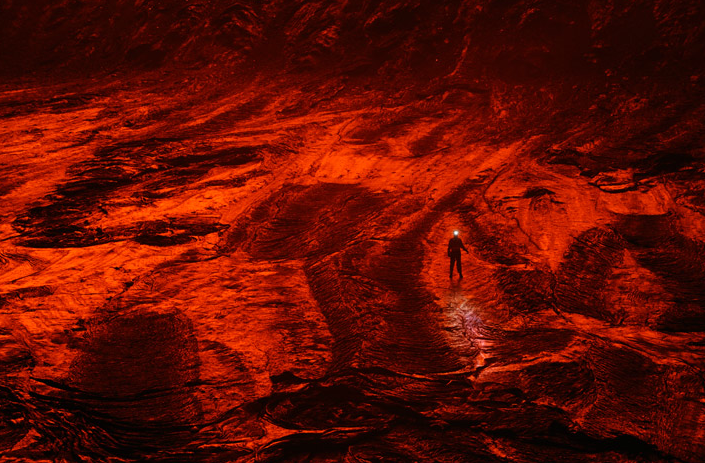

This may look like a monster walking out of the bowels of hell, but it is actually a member of a research team walking across a cooled lava floor which has been turned red by the reflected glow of the lave lake nearby. “Down here you feel the volcano,” says photographer Carsten Peter. “It’s a low-frequency rumbling that pulses through your body—like being inside a giant subwoofer.”
Located in the heart of the Great Lakes region of Africa, the lava lake of the Nyiragongo Crater is one of the greatest natural wonders that can be found on the African continent. With a depth of about 1,300 feet and a height of about two miles, it’s also the largest lava lake in the world. And it contains an estimated 282 million cubic feet of molten lava.
Currently, Mount Nyiragongo is one of the most active volcanoes in the world; it’s also one of the least studied. Vulcanologists (people that study volcanoes) are scurrying to understand the mechanisms driving it, as an estimated two million people live in the city of Goma, which lies at the base of the volcano. It has been dubbed by some seismologists as the most dangerous city in the world.
For a good reason too.

Back in 1977, several hundreds of people died when lava was spit out of the volcano. Traveling at an estimated 60 mph, this is the fastest volcanic flow that has ever been directly observed. Furthermore, over 15 million cubic yards of lava shot out of Nyiragongo in 2002, destroying 14,000 homes and forcing the evacuation of over 350,000 citizens. Both of these eruptions were minor incidents compared to the utter havoc Nyiragongo is capable of wreaking.
Understanding the volcano is pivotal in order to be able to predict when an eruption is due and give residents the precious time that they will need to evacuate beforehand, ultimately saving millions of lives.Lastly, The Mount Nyiragongo volcano is the most geologically active of the eight volcanoes that compromise the Virunga Mountains range in East Africa. Those include Karisimbi, Mount Mikeno, Mount Muhabura, Mount Bisoke, Mount Sabyinyo, Mount Gahinga, and Mount Nyamuragira. Most of these remain dormant.
See a zoomable version here.